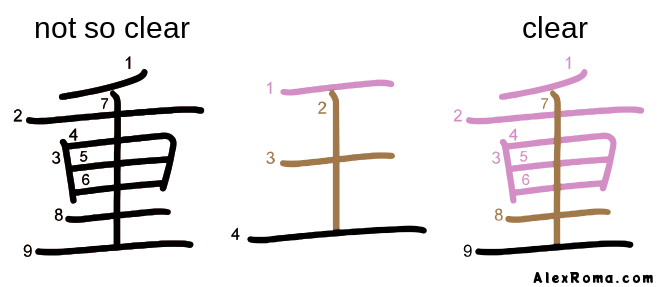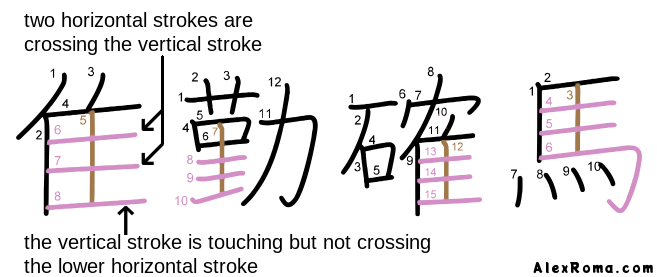Stroke order rule 4 – crossing horizontal first
This rule is exemplified by the kanji 十 too ‘ten’, which we have seen in stroke direction rule 1 and rule 2. The crossing horizontal first rule says:
When two strokes intersect forming a plus shape (十), the horizontal stroke is written first.
The next diagram shows the kanji 土 tsuchi, 七 nanatsu, 午 GO, 寸 SUN, 木 ki.

If we take 午 GO into consideration, we can see that the highlighted horizontal (3rd) stroke is written before the vertical (4th) stroke. This rule should be intuitive to most people as the plus (+) symbol used in mathematics is written in the same way.
Exceptions: the rice field and the king
There are two major exceptions to stroke order rule 4 that should be memorised and practised. They are:
- 田 ta ‘rice field’ type exceptions, and
- 王 OU ‘king’ type exceptions.
In the diagram the highlighted crosses constitute the exception, which is to say that in these shapes the vertical stroke is written first, as the stroke diagram clearly indicates.

In the next diagram:
- the kanji 由 YUU and 角 kado contain 田 ta-type exceptions;
- the kanji 青 ao and 生 ikiru contain 王 OU-type exceptions.

I would like to present another well concealed 王 OU-type exception in the character 重 omoi ‘heavy’.
The diagram compares 王 OU and 重 omoi, highlighting in red the strokes that can be considered to play a similar role in the stroke-balance of the two characters. The 王 OU-type exception is shown in brown.

The kanji 重 omoi is an important character to master in your kanji stroke order learning. Practice writing it until it is committed to muscle memory. My advice is: write it 30 times a day for one week.
Exception: the old bird
There is one more notable exception to stroke order rule 4 which could be described like so:
A vertical stroke is written first when it is crossed by two or more horizontal strokes, and it is touching but not crossing a lower horizontal stroke.
I called this exception the 隹 furutori ‘old bird’ type exception because it is exemplified in the shape 隹 furutori.

The diagram shows the shape 隹 furutori, and the kanji 勤 tsutomeru, 確 tashika and 馬 uma.
Let’s put our lens on the kanji 馬 uma. Stroke order rule 4 says that the vertical strokes should be written first, but 馬 uma is a 隹 furutori-type exception, which means that three conditions are met.
- A vertical stroke (3rd stroke) is crossed by two or more horizontal strokes (4th and 5th strokes);
- the vertical stroke is touching a lower horizontal stroke (6th stroke);
- the vertical stroke is not crossing the lower horizontal stroke.
I would advise practising these characters until you become perfectly fluent with them.
